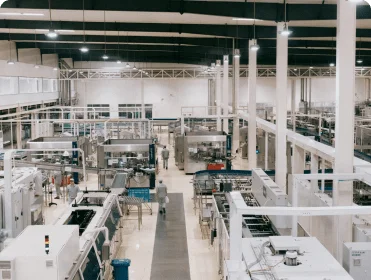Next-Generation ERP Implementation: Transforming Global Manufacturing Operations
Executive Summary
In today's rapidly evolving business landscape, efficient resource management and streamlined operations are crucial for maintaining competitiveness. HawksCode, leveraging its expertise in enterprise software development, cloud technologies, and industry 4.0 concepts, undertook a transformative project to develop and implement a next-generation Enterprise Resource Planning (ERP) system for a global manufacturing conglomerate. This case study explores the creation and deployment of a comprehensive, AI-enhanced ERP solution that revolutionized the client's operations across multiple countries and business units.
Industry Context and Challenges

Legacy System Integration:
Integrating new ERP systems with existing legacy applications and databases.
Customization vs. Standardization:
Balancing the need for standardized processes with requirements for local customizations.
Data Management:
Ensuring data consistency, accuracy, and accessibility across the entire organization.
User Adoption:
Overcoming resistance to change and ensuring widespread adoption of new systems and processes.
Real-time Visibility:
Providing real-time insights into operations, inventory, and financial performance across the global supply chain.
Industry 4.0 Integration
Incorporating emerging technologies like IoT, AI, and blockchain into traditional ERP frameworks
Global Complexity:
Managing diverse operations across multiple countries with varying regulations and business practices.
HawksCode's Innovative Approach
Recognizing the multifaceted nature of these challenges, HawksCode developed a comprehensive, next-generation ERP solution. Our approach encompassed several key components:
01
Cloud-Native Architecture
Challenge
Solution:
- Developed a cloud-native ERP architecture using microservices.
- Implemented a multi-cloud strategy for enhanced resilience and global reach.
- Created a containerized application structure for easy deployment and scaling.
Technical Deep Dive:
- Utilized Kubernetes for orchestrating microservices, with separate clusters deployed on AWS, Azure, and Google Cloud Platform for different geographical regions.
- Implemented service mesh architecture using Istio for managing microservices communication, security, and observability.
- Developed a custom CI/CD pipeline using Jenkins, GitLab, and Spinnaker for automated testing and deployment across multiple cloud environments.
02
AI-Enhanced Process Automation
Challenge
Solution:
- Implemented AI-driven process automation for key business functions.
- Developed intelligent forecasting and planning modules.
- Created an AI-assisted decision support system for management.
Technical Deep Dive:
- Implemented feature engineering pipelines to incorporate external data sources:
- Weather data (using APIs from weather services)
- Utilized Bayesian Optimization for hyperparameter tuning, ensuring optimal model performance..
- Implemented model explainability using SHAP (SHapley Additive exPlanations) values.
03
Comprehensive Data Integration and Analytics
Challenge
Solution:
- Developed a centralized data lake for aggregating data from all business units and external sources.:
- Implemented real-time analytics and reporting capabilities.
- Created customizable dashboards for different user roles and departments.
Technical Deep Dive:
- Utilized Apache Kafka for real-time data streaming from various sources, including IoT devices in manufacturing plants.
- Implemented a Lambda architecture using Apache Spark for batch processing and Apache Flink for stream processing of large-scale data.
- Developed a semantic layer using GraphQL to provide a unified interface for data access across different microservices and data sources..
04
Intelligent Supply Chain Management
Challenge
Solution:
- Implemented an AI-driven supply chain optimization module.
- Developed real-time tracking and traceability features using IoT and blockchain.
- Created predictive maintenance capabilities for manufacturing equipment.
Technical Deep Dive:
- Utilized reinforcement learning algorithms, implemented with Ray RLlib, for dynamic optimization of inventory levels and logistics routes.
- Implemented a private blockchain network using Hyperledger Fabric for end-to-end supply chain traceability, with nodes deployed across key suppliers and distribution centers.
- Developed an IoT platform using AWS IoT Core for real-time monitoring of manufacturing equipment, with edge computing capabilities for local data processing..
05
Advanced Financial Management and Compliance
Challenge
Solution:
- Developed an AI-enhanced financial management module with multi-currency support.
- Implemented automated compliance checking and reporting capabilities.
- Created a blockchain-based system for immutable financial record-keeping.
Technical Deep Dive:
- Utilized Python’s QuantLib library for complex financial calculations and risk assessments.
- Implemented a rules engine using Drools for automated compliance checking across different regulatory frameworks (GAAP, IFRS, etc.).
- Developed a machine learning system using anomaly detection algorithms (Isolation Forests, One-Class SVM) for identifying potential financial fraud or errors.
Implementation and Change Management
01
Phased Rollout
Implemented the solution in carefully planned phases, starting with pilot programs in select business units before global rollout.
02
Extensive Training
Developed role-based training programs, including e-learning modules, hands-on workshops, and a digital adoption platform for ongoing support.
03
Change Champions Network:
Identified and empowered change champions across different departments and regions to drive adoption and provide local support.
04
Continuous Communication:
Established a multi-channel communication strategy to keep all stakeholders informed throughout the implementation process.
05
Legacy System Migration:
Developed a comprehensive data migration strategy, including data cleansing, mapping, and validation processes.
06
Performance Monitoring
Implemented real-time monitoring of system performance and user adoption metrics to quickly identify and address any issues.
07
Feedback Loops:
Established mechanisms for continuous user feedback and iterative improvements to the ERP system.
Results and Impact
1. Operational Efficiency:
- 30% reduction in order-to-cash cycle time.
- 25% improvement in inventory turnover rate.
- 40% reduction in manual data entry and processing tasks.
2. Financial Performance:
- 15% reduction in overall operational costs.
- 20% improvement in cash flow management.
- 35% faster monthly financial close process.
3. Supply Chain Optimization:
- 50% reduction in stockouts.
- 30% improvement in on-time delivery rates.
- 25% reduction in logistics costs.
4. Data-Driven Decision Making:
- 60% reduction in time spent on generating reports and analytics.
- 40% improvement in forecast accuracy.
- 90% of executive decisions now backed by real-time data insights.
5. Employee Productivity and Satisfaction:
- 25% increase in employee productivity.
- 30% reduction in HR administrative tasks.
- 20-point increase in employee Net Promoter Score (eNPS).
6. Compliance and Risk Management:
- 100% compliance with global financial regulations.
- 70% reduction in audit preparation time.
- 50% decrease in identified compliance risks..
7. IT Performance and Agility:
- 99.99% system uptime achieved.
- 60% reduction in time-to-market for new ERP features and updates.
- 40% decrease in IT support tickets related to ERP functions.
8. Overall Business Impact:
- 18% increase in overall profit margins.
- 30% improvement in customer satisfaction scores.
- Enablement of 5 new data-driven business models within the first year.
Lessons Learned and Best Practices
1. User-Centric Design is Crucial:
2. Data Quality is Foundational
3 Flexibility is Key
4. Integration is Complex but Critical:
5. Change Management is Half the Battle
6. Leverage Cloud Capabilities:
7. Continuous Improvement is Necessary:
8. Security by Design
Conclusion
The successful implementation of HawksCode's next-generation ERP solution demonstrates our ability to leverage cutting-edge technologies to transform complex global manufacturing operations. By combining deep industry knowledge with advanced software development expertise, we delivered a comprehensive solution that not only streamlined current processes but also positioned our client for future growth and innovation.

This case study showcases HawksCode's capabilities in:
- Developing cloud-native, microservices-based enterprise applications
- Integrating AI and machine learning into core business processes
- Implementing blockchain and IoT technologies in ERP contexts
- Managing large-scale, global software implementations
- Driving digital transformation in traditional manufacturing environments
As the manufacturing industry continues to evolve in the age of Industry 4.0, HawksCode remains committed to driving innovation through intelligent, integrated enterprise solutions. Our holistic approach, combining technological expertise with strategic business insights, enables us to deliver transformative ERP systems that drive tangible, long-lasting value for our clients in the manufacturing sector and beyond.






